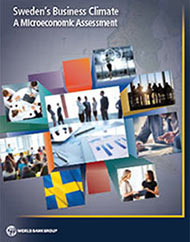Main Findings
- Labor issues—lack of skills in the work force and restrictive labor laws—are the most pressing for Sweden’s private sector firms. Twenty-eight percent of Swedish firms cite the lack of skilled workers as the most important obstacle for their operations, followed by labor laws, which are cited by 18 percent of firms.
- The use of fixed-term contracts is common in Sweden and is beneficial for the private sector because it is associated with higher labor productivity and higher growth rates of employment and sales in the manufacturing sector. Nonetheless, worker turn-over (churning), for one, is substantial, but is masked by a small net change in employment.
- One in five firms in Sweden reports not hiring additional workers because of high taxes or high contribution rates to social safety net programs. In particular, firms seeking mainly skilled workers are nearly twice as likely to report being constrained in hiring for tax-related reasons compared to firms seeking mainly unskilled workers.
- Many jobs in Sweden require some specialized knowledge or skill, but only a relatively small percentage of the workforce has completed tertiary education. Sectors that require more specialized workers are more likely to experience frictions in the labor market, although labor productivity does not seem to be affected.
- Innovative firms in Sweden significantly outperform their non-innovative counterparts on most indicators of technological capacity and technology transfer. Labor market and tax regulations appear to be greater obstacles for innovative firms than non-innovative ones. Yet there is no significant relationship between innovation and labor productivity, possibly due to diminishing returns to innovative efforts associated with heightened competition close to the technological frontier.
- Sweden has a healthy financial market: to a large extent Swedish authorities have been successful in creating an environment conducive to private firms’ access to credit. Credit-constrained firms in Sweden tend to spend less on R&D and have lower sales growth than firms that are not credit constrained. The relatively low ranking in the getting credit indicator of the World Bank’s Doing Business indicators does not seem to have affected firms’ access to credit.
- Women are well integrated into the private sector in Sweden when broader measures of firm ownership and management are considered. However, the picture changes dramatically when the focus shifts to upper levels of responsibility and decision making. Women account for only 23 percent of all managers in a typical firm in Sweden and firms with women top managers and female-owned firms are concentrated in the services sector.

